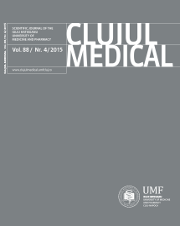Investigation of thyroid nodules in the female population in Cyprus and in Romania
DOI:
https://doi.org/10.15386/cjmed-518Keywords:
thyroid nodules, thyroiditis, thyroid cancer, Bisphenol A, environmental exposureAbstract
Background and aims. The most common thyroid disorders, with an increasing detection worldwide, are the thyroid nodules and thyroiditis, which leads to an increase of thyroid cancer incidence . In two different countries with a different exposure to risk factors for thyroid cancer, such as Cyprus and Romania, the rank of thyroid cancer among other neoplasms is very different: the 3rd most prevalent cancer among females in Cyprus and the 12th in Romania, respectively. Environmental chemicals, such as bisphenol A have a proven effect on the thyroid function. However, the relation between the exposure to the endocrine disruptor and the development of thyroid nodules, with a potential of malignant transformation has not been previously studied. The aim of the study was to investigate the potential factors that lead to the difference of thyroid nodules incidence in the mentioned countries.
Methods. A pilot case-control study has been conducted in 2014-2015 in the “Prof. Dr. Ion Chiricuță” Institute of Oncology, Cluj-Napoca, Romania and the Endocrinology Department of Archbishop Makarios III Hospital, Nicosia, Cyprus. Females older than 20 years with no medical history were recruited. Cases were women with ultrasound-confirmed thyroid nodules of size >3mm. Controls were women without thyroid nodules after ultrasound confirmation. All participants provided blood samples for measurements of the thyroid stimulating hormone (TSH), free thyroxin (FT4), anti- thyroglobulin (ATg) and anti-thyroid peroxidase (ATPO); urine samples. Demographics, anthropometrics and other relevant information were provided through the administration of a questionnaire.
Results. In Romania we selected 51 patients with thyroid nodules (case group) and 41 without thyroid nodules (control group) and in Cyprus 57 cases, respectively 65 controls. After the statistical analysis of the data collected we observed statistically significant differences between the populations of the two countries regarding BMI and the value of the thyroid hormones and antibodies.
Conclusions. Using the data observed in this study, differences were found between Cyprus and Romania among females with thyroid nodules the BMI, and the level of thyroid hormones had statistically significant differences. This study reports preliminary data, further analysis of environmental exposures to chemical factors that might have a certain influence over the thyroid in the two countries will follow.
Downloads
Additional Files
Published
How to Cite
Issue
Section
License
The authors are required to transfer the copyright of the published paper to the journal. This is done by agreeing to sign the Copyright Assignment Form. Whenever the case, authors are also required to send permissions to reproduce material (such as illustrations) from the copyright holder.

The papers published in the journal are licensed under a Creative Commons Attribution-NonCommercial-NoDerivatives 4.0 International License.

